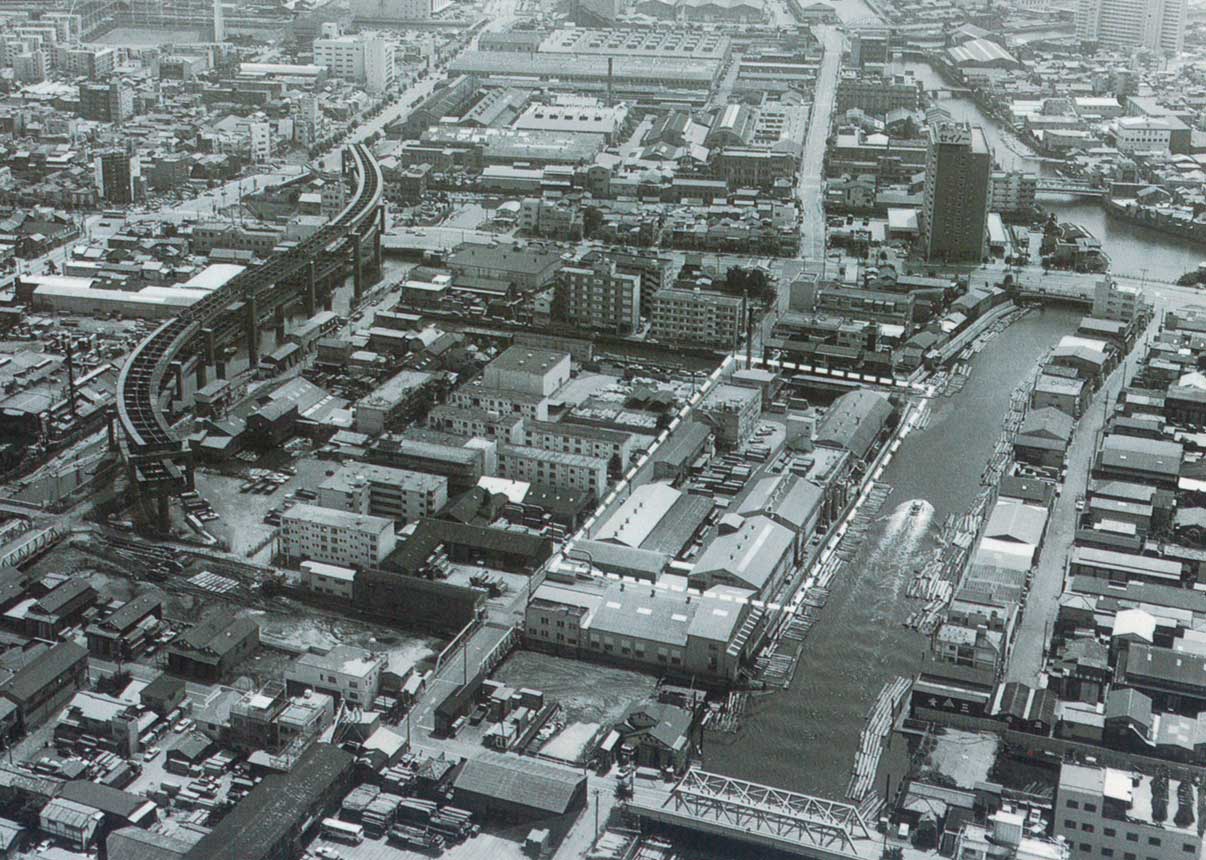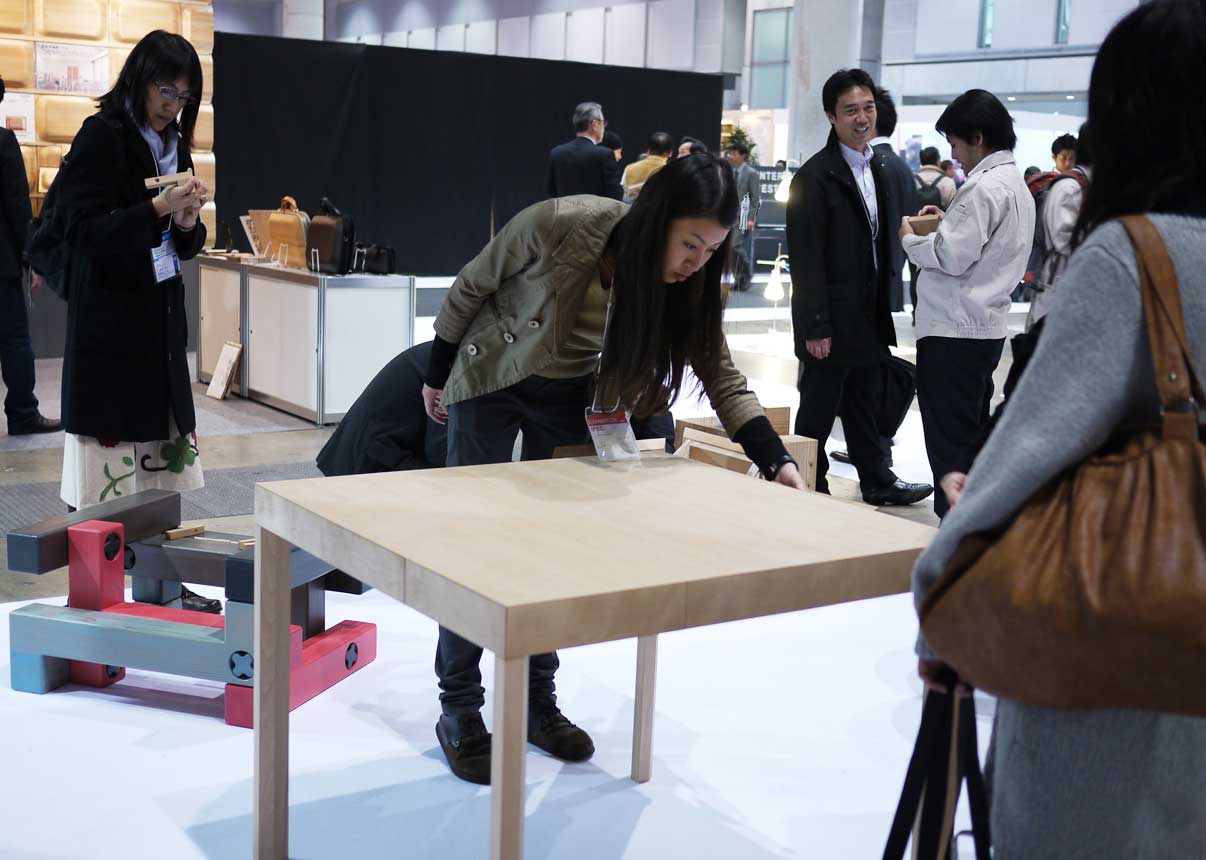History of Tokyo Mokkoujou Arts & Crafts Furnishings
1884-1926 (Meiji-Taisho periods)

The history of Tokyo Mokkoujou Arts & Crafts Furnishings traces back to 1884, more than 130 years ago. The facility opened when Shimizu Gumi (now Shimizu Corporation) acquired the former site of the Shogunate’s official lumber supplier in Fukagawa-Shimadacho (now Kiba, Koto-ku, Tokyo) and began using it for lumber processing.
It was later renamed Fukagawa Works and equipped with saws, woodworking equipment, and other machinery to meet growing demand from the construction industry. When the Great Kanto Earthquake of 1923, Fukagawa Works contributed to the reconstruction of Tokyo as a lumber collection point.
1884
1896
1909
1923

The history of Tokyo Mokkoujou Arts & Crafts Furnishings traces back to 1884, more than 130 years ago. The facility opened when Shimizu Gumi (now Shimizu Corporation) acquired the former site of the Shogunate’s official lumber supplier in Fukagawa-Shimadacho (now Kiba, Koto-ku, Tokyo) and began using it for lumber processing.
It was later renamed Fukagawa Works and equipped with saws, woodworking equipment, and other machinery to meet growing demand from the construction industry. When the Great Kanto Earthquake of 1923, Fukagawa Works contributed to the reconstruction of Tokyo as a lumber collection point.
1884
Opened at Fukagawa-Shimadacho (now Kiba, Koto-ku, Tokyo) as a lumber processing facility of Shimizu Gumi1896
Installed steam-powered saw machinery to meet demand for lumber at various construction sites1909
Installed more saw machinery and fitting machinery and renamed Fukagawa Works1923
When the Great Kanto Earthquake, Fukagawa Works contributed to the reconstruction of Tokyo as a lumber collection point.1926-1989 (Showa Period)

In 1945, the facility was quickly rebuilt after it was destroyed during World WarⅡ. Tokyo Mokkoujou helped procuring lumbers needed for postwar reconstruction while it continued to expand its plant facilities. In 1955, Tokyo Mokkoujou installed long hot presses, high-frequency equipment and other types of woodworking equipment and installed constant temperature and humidity plant. These efforts improved the quality of its wood products and expanded operating capacity. In 1962, Shimizu renamed the facility Tokyo Mokkoujou and built Plant No. 4 to meet the growing demand for wood construction and installed multilevel hot presses. The new plant also launched and mass production of flush doors for the first time that is significantly expanded plant capacity. In 1979, Tokyo Mokkoujou adopted a total quality control (TQC) program, Shimizu’s company-wide initiatives, and began organizational reforms to further improve quality.

1945
1952
1955
1956
1962
1967
Capabilities of the new long hot press demonstrated in construction on the Imperial Palace
1969
1979
1983
Shimizu is awarded the Deming Prize for implementation of a total quality control (TQC) system
1988

In 1945, the facility was quickly rebuilt after it was destroyed during World WarⅡ. Tokyo Mokkoujou helped procuring lumbers needed for postwar reconstruction while it continued to expand its plant facilities. In 1955, Tokyo Mokkoujou installed long hot presses, high-frequency equipment and other types of woodworking equipment and installed constant temperature and humidity plant. These efforts improved the quality of its wood products and expanded operating capacity. In 1962, Shimizu renamed the facility Tokyo Mokkoujou and built Plant No. 4 to meet the growing demand for wood construction and installed multilevel hot presses. The new plant also launched and mass production of flush doors for the first time that is significantly expanded plant capacity. In 1979, Tokyo Mokkoujou adopted a total quality control (TQC) program, Shimizu’s company-wide initiatives, and began organizational reforms to further improve quality.

1945
Rebuilt after World WarⅡand expanded its factory facilities while cooperating in procuring materials necessary for the reconstruction of Japan.1952
Veneering begins with the development of new woodworking technology1955
New fitting plant opened to improve the quality of fitting and increase capacity. Installed new hot press and began produce of high-end decorative plywood with veneer sheets.1956
New high-frequency bonding equipment installed to form wood materials1962
Facility renamed Tokyo Mokkoujou and new Plant No. 4 built to meet growing demand for lumber processing. New multilevel hot presses installed in response to rapid growth in plywood processing and began mass production of flush doors.1967
New Plant No. 3 builtCapabilities of the new long hot press demonstrated in construction on the Imperial Palace
1969
Shimizu develops fire-resistant, high-end decorative plywood with natural veneer sheets(” SHIMIZ high-end decorative plywood”) and acquires certification by the Minister of Construction1979
Total quality control (TQC) system, Shimizu’s company-wide initiatives, adopted1983
Tokyo Mokkoujou earns certification from the Minister of Economy, Trade and Industry as a plant demonstrating outstanding quality control in the production of factory-produced houses and other productsShimizu is awarded the Deming Prize for implementation of a total quality control (TQC) system
1988
Shimizu receives outstanding safety award from the Minister of Labor1989 through the Present (Heisei-Reiwa Period)

Employees, consisting mainly of the young employees, have participated actively in competitions to further improve their technical skills since 1997. Tokyo Mokkoujou’s woodworking techniques have won awards in a wide range of competitions, including the Skills Grand Prix, a national competition among holders of first grade certification under the National Trade Skill Testing and Certification. (See “Awards” for more information)
1992
1994
1996
1997
Awarded gold medal and Minister of Labour Prize in the Skills Grand Prix, Furniture category
2003
Awarded gold medal and Minister of Health, Labour and Welfare Prize in the Skills Grand Prix, Furniture category
2004
Awarded gold medal in the 42nd National Skills Competition, Furniture Professions category
2005
Awarded Minister of Health, Labour and Welfare Prize in the 23rd Skills Grand Prix, Furniture category
Competed in the WorldSkills Competition, in the Furniture Professions category
2008
Awarded gold medal in the 45th National Skills Competition, Furniture Professions category
2009
Awarded gold medal in the 47th National Skills Competition, Furniture Professions category
2010
Awarded gold medal in the 48th National Skills Competition, Furniture Professions category
Received merit award at Interior Pro Ex Co (IPEC) 2010
2011
Awarded gold medal and Minister of Health, Labour and Welfare Prize in the 26th Skills Grand Prix, Furniture category
Two employees awarded silver medals in the 49th National Skills Competition, Furniture Professions category
Installed NC router and door jamb machinery
2012
Opened Showroom
2013
Installed laser wood cutting machine
2014
Installed new sawdust collection system
2015
Installed second laser wood cutting machine
2018
Installed second NC router
2020
Registered Company of The Act on Promotion of Use and Distribution of Legally-harvested Wood and Wood Products(the Clean Wood Act)
2021
Awarded gold medal and Minister of Health, Labour and Welfare Prize in the 31th Skills Grand Prix, Furniture category

Employees, consisting mainly of the young employees, have participated actively in competitions to further improve their technical skills since 1997. Tokyo Mokkoujou’s woodworking techniques have won awards in a wide range of competitions, including the Skills Grand Prix, a national competition among holders of first grade certification under the National Trade Skill Testing and Certification. (See “Awards” for more information)
1992
Full-scale adoption of CAD system to streamline design operations1994
Awarded longest record of no accident by industry (3,317,714 hours)1996
Earned ISO 9001 certification from the Japan Testing Center for Construction Materials1997
Awarded gold medal and Minister of Labour Prize in the Skills Grand Prix, Furniture category
2003
Awarded gold medal and Minister of Health, Labour and Welfare Prize in the Skills Grand Prix, Furniture category
2004
Awarded gold medal in the 42nd National Skills Competition, Furniture Professions category
2005
Awarded Minister of Health, Labour and Welfare Prize in the 23rd Skills Grand Prix, Furniture category
Competed in the WorldSkills Competition, in the Furniture Professions category
2008
Awarded gold medal in the 45th National Skills Competition, Furniture Professions category
2009
Awarded gold medal in the 47th National Skills Competition, Furniture Professions category
2010
Awarded gold medal in the 48th National Skills Competition, Furniture Professions category
Received merit award at Interior Pro Ex Co (IPEC) 2010
2011
Awarded gold medal and Minister of Health, Labour and Welfare Prize in the 26th Skills Grand Prix, Furniture category
Two employees awarded silver medals in the 49th National Skills Competition, Furniture Professions category
Installed NC router and door jamb machinery
2012
Opened Showroom
2013
Installed laser wood cutting machine
2014
Installed new sawdust collection system
2015
Installed second laser wood cutting machine
2018
Installed second NC router
2020
Registered Company of The Act on Promotion of Use and Distribution of Legally-harvested Wood and Wood Products(the Clean Wood Act)
2021
Awarded gold medal and Minister of Health, Labour and Welfare Prize in the 31th Skills Grand Prix, Furniture category
